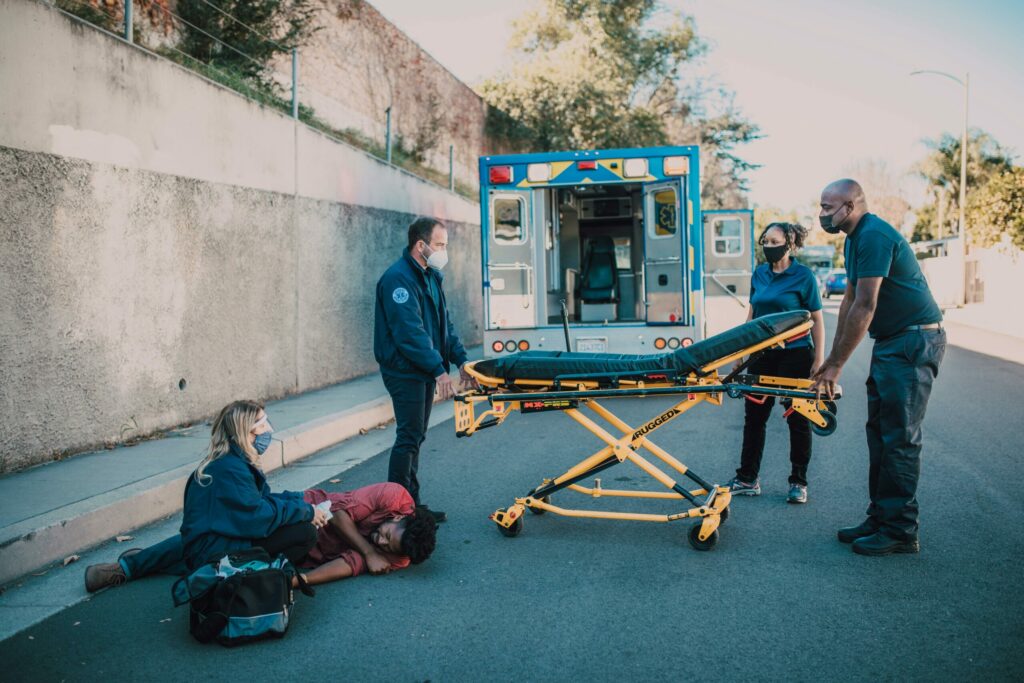First responders are pivotal in accident prevention and recovery, as they possess the capability to swiftly assess situations and mitigate risks. Their role extends beyond immediate response; it involves continuous training and strategic planning to prevent incidents. By collaborating with local organizations and conducting community education, they enhance public safety awareness. How do these efforts translate into tangible safety improvements, and what further measures can fortify community resilience?
Understanding the Scope of First Responders’ Responsibilities
While first responders are often seen solely as emergency personnel arriving at the scene of an incident, their responsibilities extend far beyond immediate crisis management. They play an essential role in establishing and adhering to emergency protocols designed to mitigate risks before they escalate. These protocols are meticulously crafted through thorough training exercises that simulate real-world scenarios, ensuring preparedness for a variety of emergencies. Through strategic planning and execution of these exercises, first responders are equipped to anticipate potential hazards, thereby enhancing community safety. By continually updating and refining these protocols, they maintain a high level of readiness. This proactive approach not only aids in efficient crisis management but also greatly contributes to accident prevention and recovery, underscoring their strategic importance beyond initial response.
The Critical Role of First Responders in Emergency Response
In the domain of emergency response, first responders are indispensable, serving as the frontline defense in crises. Their strategic role begins with adherence to established emergency protocols, ensuring swift and effective action. These protocols guide responders through structured procedures, minimizing chaos during critical incidents. Crisis management hinges on their ability to assess situations rapidly, deploy resources, and make informed decisions under pressure. This involves coordination with multiple agencies, leveraging technology, and utilizing specialized training to stabilize situations. By executing these tasks efficiently, first responders mitigate risks and prevent escalation. Their expertise in managing diverse emergencies—from natural disasters to accidents—underscores the importance of continuous training and adaptation. Consequently, first responders embody the vital link between initial crisis occurrence and subsequent recovery efforts.
Proactive Measures for Accident Prevention
A multitude of proactive measures serve as the foundation for effective accident prevention strategies. These measures involve implementing thorough safety protocols and targeted behavioral interventions. Safety protocols encompass systematic procedures designed to minimize risk, ensuring environments adhere to rigorous standards. Detailed assessments of potential hazards lead to the development of these protocols, tailored to specific sectors and scenarios. Meanwhile, behavioral interventions focus on modifying individual actions to enhance safety awareness and compliance. These interventions include training programs, reminders, and feedback systems that encourage safer behavior. By strategically deploying these initiatives, organizations reduce the likelihood of accidents, fostering a culture of vigilance and responsibility. The integration of both protocols and interventions creates a robust framework, essential for minimizing incidents and enhancing overall safety outcomes.
Conducting Safety Workshops and Community Education
Numerous organizations recognize the pivotal role of safety workshops and community education in fortifying accident prevention strategies. These initiatives are instrumental in disseminating vital safety education, fostering a culture of awareness and preparedness. Strategically designed workshops focus on practical skills and knowledge transfer, ensuring participants understand potential hazards and appropriate responses. Community engagement is enhanced through interactive sessions, which encourage active participation and feedback, thereby tailoring the education to specific local needs.
Moreover, community education initiatives empower individuals by providing them with the tools needed to identify risks and respond effectively. This proactive approach not only mitigates potential accidents but also strengthens community resilience. Ultimately, these educational efforts are essential in creating a safer environment, reducing the incidence of accidents, and promoting public safety.

Collaborating With Local Organizations for Risk Mitigation
Building upon the foundation of safety workshops and community education, effective accident prevention and recovery necessitates strategic partnerships with local organizations. Community partnerships enhance risk awareness by integrating diverse resources and expertise. Local entities such as non-profits, schools, and businesses provide first responders with valuable insights into specific community needs and potential vulnerabilities. These collaborations facilitate tailored risk mitigation strategies, optimizing resource allocation and maximizing outreach. By engaging these organizations, first responders can amplify public education efforts and foster a culture of proactive safety. Additionally, shared initiatives streamline communication channels, ensuring swift response times during emergencies. Ultimately, leveraging the strengths of local organizations cultivates a resilient community, prepared to address and recover from potential hazards effectively.
Assessing Potential Hazards in the Community
When evaluating potential hazards in the community, it is essential to adopt a thorough and systematic approach. Hazard identification begins with extensive community assessments, which involve cataloging potential risks based on geographic, demographic, and infrastructural factors. First responders and safety officials should analyze historical data, weather patterns, and industrial activities to pinpoint areas of concern. Utilizing advanced tools like geographic information systems (GIS) can enhance the accuracy of these assessments, ensuring that no potential threat is overlooked. By establishing a detailed risk profile, authorities can prioritize areas that require immediate attention and allocate resources efficiently. Continuous monitoring and periodic updating of these assessments are vital, as they adapt to new developments and emerging threats, maintaining a proactive stance in hazard management.
Implementing Preventive Strategies for Enhanced Safety
To effectively implement preventive strategies for enhanced safety, a multifaceted approach is required that integrates technology, education, and community involvement. First responders can leverage data analytics and real-time monitoring systems to identify potential risks. Preventive education plays an essential role, emphasizing the development of a proactive safety culture. Training programs should focus on equipping both responders and the public with the knowledge to recognize hazards and take preemptive action. Incorporating community feedback into strategic planning guarantees that initiatives are relevant and grounded in local contexts. Through collaboration with educational institutions, responders can develop curricula that embed safety principles into daily life. This thorough strategy, underpinned by technology and community engagement, fosters a resilient framework for accident prevention and enhanced safety.
Enhancing Community Resilience Through Expertise
Although expertise is essential in shaping resilient communities, its application must be strategically aligned with local needs and capabilities. Effective resilience strategies hinge on integrating professional knowledge with active community engagement. By tailoring expertise to address specific regional vulnerabilities, communities can better prepare for and recover from adverse events. This involves training local leaders, educating citizens, and fostering partnerships that emphasize shared responsibility.
Data-driven decision-making and scenario planning further enhance these strategies by providing accurate risk assessments and actionable insights. These components guarantee that communities are not only reactive but proactive, thereby strengthening their adaptive capacities. Ultimately, the strategic alignment of expertise with localized engagement cultivates robust and self-sufficient communities, ready to withstand and recover from future adversities.
Appreciating the Invaluable Contribution of First Responders
In the intricate framework of accident prevention and recovery, the role of first responders is indispensable, serving as the frontline in crisis situations. Their heroic dedication is evident in their swift actions, which not only mitigate immediate threats but also lay the groundwork for effective recovery. Strategically positioned, they are the initial point of contact, providing critical interventions that often determine the outcome of emergencies. Their efforts are bolstered by community support, which enhances resource availability and operational efficiency. This cooperative dynamic fosters resilience, allowing for a more robust response to crises. Acknowledging their contributions requires a focus on continuous training and resource allocation, ensuring these professionals remain equipped to face evolving challenges and maintain public safety.
Frequently Asked Questions
How Do First Responders Manage Stress and Mental Health?
First responders employ stress management techniques, including mindfulness and physical exercise, to enhance mental resilience. Strategic access to mental health resources, peer support systems, and professional counseling further aids in sustaining their psychological well-being amidst challenging situations.
What Technology Aids Do First Responders Use During Emergencies?
In emergencies, first responders strategically employ drones for aerial surveillance and communication devices to enhance coordination. Drones usage facilitates situational awareness, while advanced communication devices guarantee real-time data exchange, optimizing response efficiency and decision-making processes.
What Are the Typical Qualifications for Becoming a First Responder?
The typical qualifications for becoming a first responder include meeting certification requirements specific to the role, such as EMT or firefighter credentials, and maintaining physical fitness standards to guarantee readiness for the demanding nature of emergency situations.
How Do First Responders Coordinate With Other Emergency Services?
First responders coordinate with other emergency services through established communication protocols and joint operations. These strategies guarantee efficient information sharing, resource allocation, and synchronized efforts, optimizing response times and effectiveness during emergencies, thereby minimizing chaos and maximizing safety.
How Do First Responders Prioritize Resources During Large-Scale Accidents?
During large-scale accidents, first responders prioritize resources through strategic resource allocation and the incident command system. They assess the situation, determine urgency levels, allocate personnel, and manage equipment to optimize response effectiveness and guarantee public safety.

